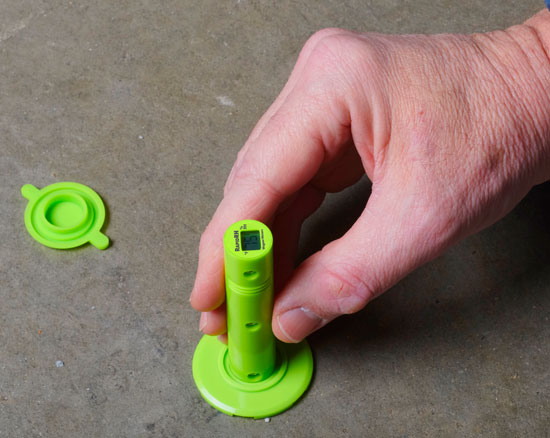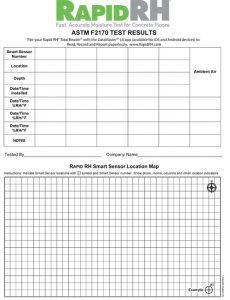Does It Matter How Many Concrete Moisture Tests I Use

The relative humidity (RH) test method for determining the moisture condition of concrete slabs has been shown to be the most reliably accurate testing method available.
Why Proper Moisture Testing Matters
Moisture testing is a critical step in any flooring installation over a concrete slab. Excess moisture in concrete can lead to costly failures, such as adhesive breakdown, warping, or mold growth. Following ASTM F2170 guidelines ensures accurate data, reducing the risk of flooring failures and preserving both your work and reputation.
The ASTM F2170 standard specifies the use of relative humidity (RH) in situ probes to measure the internal moisture condition of a concrete slab. This method is scientifically proven to be the most accurate, providing reliable insights into the long-term moisture behavior of concrete once it’s sealed with a flooring material.
How Many RH Sensors Do You Need?
ASTM F2170 outlines a clear formula for determining the number of RH sensors required:
- Three sensors for the first 1,000 square feet
- One additional sensor for each additional 1,000 square feet
For example, if you are testing a 10,000-square-foot concrete slab:
- The first 1,000 sq. ft. requires 3 sensors
- The remaining 9,000 sq. ft. requires 9 additional sensors
- Total: 12 sensors
This requirement ensures sufficient data points to accurately assess moisture conditions across the entire floor.

A map or diagram of the location of all RH sensors that were installed provides supporting documentation that testing was done in compliance with the F2170 standard.
Why the 1,000-Square-Foot Rule Exists
The 1,000-square-foot guideline is based on a combination of logic, mathematics, statistics, and science:
- Concrete Pouring and Variability: Concrete slabs are typically poured in sections, and a 1,000-square-foot slab at a 4-inch depth represents approximately one truckload of wet concrete. Since the water-to-cement ratio can vary between loads, each truckload should be tested to detect inconsistencies.
- Moisture Gradients in Concrete: Moisture in concrete does not distribute evenly—it moves toward the surface as the slab dries. Surface-based tests (e.g., calcium chloride tests) only measure the topmost layer, which is highly influenced by ambient conditions. RH probes inserted at 40% depth (or 20% for drying from two sides) provide a much more accurate picture of the overall moisture condition.
- Avoiding Data Errors: When drilling for RH probes, there is a chance of hitting large aggregate pieces, leading to inaccurate readings. Using three sensors in the first 1,000 sq. ft. reduces the likelihood of skewed data and ensures at least one probe hits a representative moisture level.
Where to Place RH Sensors
ASTM F2170 also provides guidance on where to place moisture sensors:
- Within 3 feet of exterior walls: Exterior walls can introduce additional moisture due to groundwater intrusion, especially in slabs-on-grade.
- Areas with varying conditions: Different concrete mixes, pours, and exposure to sunlight or airflow can impact drying rates.
- Moisture ‘hot spots’: Use a surface concrete moisture meter like the Wagner Meters C555 to identify areas with potentially higher moisture levels before installing RH probes.
The Rapid RH L6 System: Fast, Accurate, and Easy-to-Use
For flooring professionals who need quick and reliable moisture readings, the Rapid RH L6 system from Wagner Meters is the industry-leading choice. It offers:
- Single-use, factory-calibrated sensors: No recalibration is necessary, ensuring consistent accuracy.
- Faster equilibration time: Ready for readings within 24 hours, unlike reusable probes that require repositioning and re-equilibration.
- Data integrity with the DataMaster™ L6 app: Readings are stored digitally and can be accessed instantly via Bluetooth®.
Using the Rapid RH L6 and DataMaster L6 app, you can automate and streamline your moisture testing, ensuring compliance with ASTM F2170 while improving workflow efficiency.
Conclusion: Compliance Equals Confidence
Moisture-related flooring failures are preventable with the right testing approach. By adhering to ASTM F2170 guidelines and using the correct number of RH sensors, you ensure the highest accuracy in your moisture readings. The Rapid RH L6 system simplifies the process, making it faster, more reliable, and data-driven.
For flooring professionals, following these best practices not only safeguards your projects but also enhances your credibility and trust with clients. Don’t cut corners—invest in proper testing today and ensure durable, long-lasting flooring installations.
Download the Rapid RH ASTM F2170 Checklist – Ensure Accurate RH Testing Every Time!
Jason has 20+ years’ experience in sales and sales management in a spectrum of industries and has successfully launched a variety of products to the market, including the original Rapid RH® concrete moisture tests. He currently works with Wagner Meters as our Rapid RH® product sales manager.
Last updated on February 20th, 2025




I have a residential basement area that is 500 ft/2. Some of the floor area had been cut out for plumbing repair and filled with concrete (about 2 years ago. How many probes should I set?
Arthur:
Thanks for the question. The standard requires that you put 3 tests in the first 1000sqft. Which is 0-1000 sqft. Good luck.